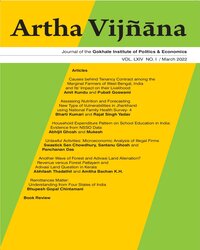Limitations and Data Gaps at Village and Block Levels on Welfare Schemes of Rural Poor Households
Subscribe/Renew Journal
There are limitations and data gaps at village and block levels on welfare schemes of rural poor households. Data is an important input to measure the impact of a scheme. However, the government offices did not collect statistics on welfare schemes. So, it is difficult to assess actual impact of particular schemes on poor households. No data are available at taluka and block levels in respect of important socio-economic indicators such as quality education, per capita income, poverty ratio, monthly expenditure, life expectancy, infant mortality, etc. Two conclusions can be drawn. Firstly, the record keeping system is not well established and not a part of system or practice. Secondly, the government functionaries were hesitant to divulge any details of spending on the schemes. Record keeping system needs to be strengthened to achieve higher impact on the targeted groups and correction of mistakes. Data sets lead researchers to find out the answers of some basic research questions.
Subscription
Login to verify subscription
User
Font Size
Information



